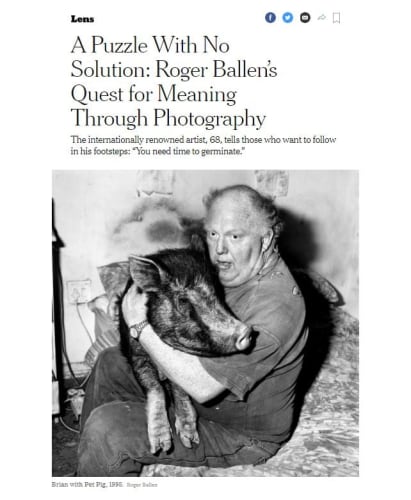
Roger Ballen grew up immersed in the photography world. His mother, Adrienne, was an editor at Magnum, and the walls of his childhood home in Rye, N.Y., were filled with her colleagues’ images.
“By the time I went out to photograph seriously, which was around the age of eighteen, I had a clear idea of the level I was aiming at,” Mr. Ballen, 68, writes in “Ballenesque, Roger Ballen: A Retrospective,” the first retrospective book of his career, which Thames & Hudson published in October.
While Mr. Ballen, an internationally renowned artist with nearly a dozen books to his name, has photographed virtually his entire life, he didn’t start thinking of himself as an artist until his late 40s. He stopped working as a geologist only in his 50s. He directed his first viral music video in his 60s.
“Students often ask me, ‘What is my suggestion if they want to become an artist?’ I say, ‘The best suggestion I can offer is have another career.’ It’s a very hard profession to make a living in and you need time to germinate,” he said.
Mr. Ballen’s own artistic germination began after his mother’s death in 1973. After briefly studying painting at the Art Students League of New York, he decided to leave the United States behind and travel the world. Over the next five years, Mr. Ballen photographed everywhere from Cairo to Cape Town in the tradition of the street photographers he grew up admiring. His photographs of boys he encountered along the way became the subject of his first book, “Boyhood,” published in 1979.
Those photos are recognizably Ballen photographs, but the hallmarks of his aesthetic — the windowless rooms, the absurdist juxtapositions, the recurring cast of otherworldly characters — didn’t truly emerge in his work until the early 1980s, when he moved to South Africa to pursue a career in mineral exploration. As he traveled the countryside for his geological work, he became drawn to the country’s remote dorps, or small towns, and the marginalized white people who lived there.
One day, he finally gathered the courage to knock on the door of a home in Hopetown and ask to photograph inside. Stepping through that threshold, he said, was a “tipping point” in his career, the beginning not only of his documentation of outsiders, but of his attempts at probing his own psyche through his photography.
“That’s what my photography has been about all these years: defining Roger, and Roger’s relationship to the world, and the world’s relationship to Roger, and Roger’s relationship to deeper philosophical issues of the human condition,” he said.
After the publication of “Dorps” (1986) and “Platteland” (1994), Mr. Ballen’s interest moved beyond the particularities of the dorps, and, moreover, the particularities of South Africa. His new intent, he wrote, was to “reveal the universal circumstances of life.” To that end, rather than photograph people in their own environments, he began bringing them to select locations — including squats, abandoned buildings and other “places of disorder” — where they became actors of sorts in scenes designed to illustrate Mr. Ballen’s distinct perspective on human nature.
“For me, art has been a way of defining the meaningless, defining issues of death, defining issues of my place in the world or lack of place, issues of enigma — things that you’ll never come to terms with in any real way,” he said.
Over the years, Mr. Ballen’s scenes have become increasingly elaborate and theatrical. His props, masks, drawings and sculptures have come to feature more prominently in his images than people, to the extent that the results often look more like mixed media collages than photographs.
On a few occasions, he has eschewed the real world entirely and reconstructed his aesthetic in three-dimensional installations. In 2012, he created a Roger Ballen-style kitchen, bathroom and living room to serve as a set for a music video by the South African rap-rave group Die Antwoord. Mr. Ballen co-directed the “I Fink U Freeky” video, which has garnered hundreds of millions of views online, and later released a book of photos featuring the duo.
Mr. Ballen’s artistic evolution is continuing. He currently makes photographs five days a week. For several years, he’s been working on a series of photos mostly focusing on rats. And in the past couple of months, he said, he’s made “a big jump” by photographing, for the first time in his career, in color.
Mr. Ballen’s quest for meaning, he said, is “an endless end,” a puzzle with no solution. But as long as he continues to work, he said, he’ll continue to search for answers, and to seek new avenues for expressing himself and his vision.
“I need to be inspired by my own work,” he said. “There’s no point being inspired by Picasso. It’s O.K., but it doesn’t help you. If you’re an artist, you have to thrive on what you do and believe in what you do and be obsessed with it.”
From April 26 to June 15, Fahey/Klein Gallery in Los Angeles will present a solo exhibition drawn from Ballen’s retrospective book.